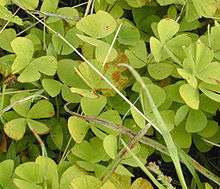Salviniales
The order Salviniales (formerly known as the Hydropteridales and including the former Marsileales) is an order of ferns in the class Polypodiopsida.[1]
| Salviniales, the water ferns | |
|---|---|
 | |
| Marsilea villosa | |
| Scientific classification | |
| Kingdom: | Plantae |
| Clade: | Tracheophytes |
| Class: | Polypodiopsida |
| Subclass: | Polypodiidae |
| Order: | Salviniales Link |
| Families | |
| |
| Synonyms | |
| |
Description
Salviniales are all aquatic and differ from all other ferns in being heterosporous, meaning that they produce two different types of spores (megaspores and microspores) that develop into two different types of gametophytes (female and male gametophytes, respectively), and in that their gametophytes are endosporic, meaning that they never grow outside the spore wall and cannot become larger than the spores that produced them. The megasporangia each produce a single megaspore.[1] In being heterosporus with endosporic gametophytes they are more similar to seed plants than to other ferns.
The fertile and sterile leaves are dimorphic, taking on a different shape, and leaves bear anastomosing veins. Aerenchyma is frequently present in roots, shoots, and petioles (leaf stalks).[1]
The ferns of this order vary radically in form from one another and do not look particularly fern-like. Species of the family Salviniaceae are natant (floating), while those of the family Marsileaceae are rooted. However, the natant species may temporarily grow on wet mud during times of low water, and the Marsileaceae may grow as emergent species, depending on species and location.
The group has also the smallest known genomes of all ferns. One genus, Azolla, is amongst the fastest growing plants on earth and caused a cooling of the climate in the Azolla event about 50 million years ago.[2]
There is a well-known fossil member of the Marsileales, Hydropteris (incertae sedis).
Classification
In the molecular phylogenetic classification of Smith et al. in 2006, the Salviniales were placed in the leptosporangiate ferns, class Polypodiopsida. Two families, Marsileaceae and Salviniaceae, were recognized.[1] The linear sequence of Christenhusz et al. (2011), intended for compatibility with the classification of Chase and Reveal (2009)[3] which placed all land plants in Equisetopsida,[4] reclassified Smith's Polypodiopsida as subclass Polypodiidae and placed the Salviniales there. The circumscription of the order and its families was not changed,[3] and that circumscription and placement in Polypodiidae has subsequently been followed in the classifications of Christenhusz and Chase (2014)[5] and PPG I (2016).[6]
The likely phylogenic relationships between the two families and five genera of the Salviniales are shown in the following diagram.[7][8]
| Salviniales |
| ||||||||||||||||||||||||||||||
References
- Smith, Alan R.; Pryer, Kathleen M.; Schuettpelz, Eric; Korall, Petra; Schneider, Harald; Wolf, Paul G. (August 2006). "A classification for extant ferns" (PDF). Taxon. 55 (3): 705–731. doi:10.2307/25065646. JSTOR 25065646.
- Fern genomes elucidate land plant evolution and cyanobacterial symbioses - Nature
- Christenhusz, Maarten J. M.; Zhang, Xian-Chun; Schneider, Harald (18 February 2011). "A linear sequence of extant families and genera of lycophytes and ferns" (PDF). Phytotaxa. 19: 7–54. doi:10.11646/phytotaxa.19.1.2. hdl:10138/28042.
- Chase, Mark W.; Reveal, James L. (October 2009). "A phylogenetic classification of the land plants to accompany APG III". Botanical Journal of the Linnean Society. 161 (2): 122. doi:10.1111/j.1095-8339.2009.01002.x.
- Christenhusz, Maarten J. M.; Chase, Mark W. (13 February 2014). "Trends and concepts in fern classification". Annals of Botany. 113 (4): 571–594. doi:10.1093/aob/mct299. PMC 3936591. PMID 24532607.
- The Pteridophyte Phylogeny Group (November 2016). "A community-derived classification for extant lycophytes and ferns". Journal of Systematics and Evolution. 54 (6): 563–603. doi:10.1111/jse.12229.
- Nathalie S. Nagalingum, Michael D. Nowak & Kathleen M. Pryer (2008). "Assessing phylogenetic relationships in extant heterosporous ferns (Salviniales), with a focus on Pilularia and Salvinia" (PDF). Botanical Journal of the Linnean Society. 157 (4): 673–685. doi:10.1111/j.1095-8339.2008.00806.x.
- Maarten J. M. Christenhusz, Xian-Chun Zhang & Harald Schneider (2011). "A linear sequence of extant families and genera of lycophytes and ferns" (PDF). Phytotaxa. 19: 7–54. doi:10.11646/phytotaxa.19.1.2. hdl:10138/28042.
- C.Michael Hogan. 2010. Fern. Encyclopedia of Earth. National council for Science and the Environment. Washington, DC